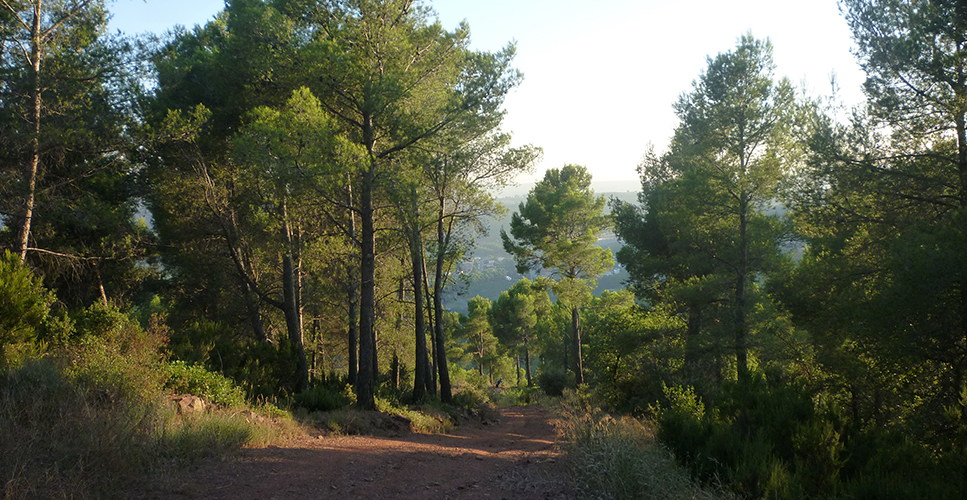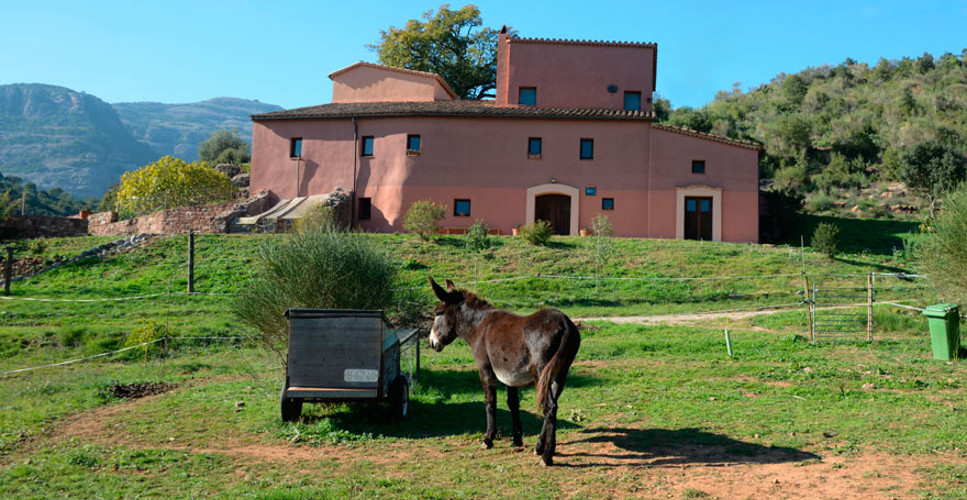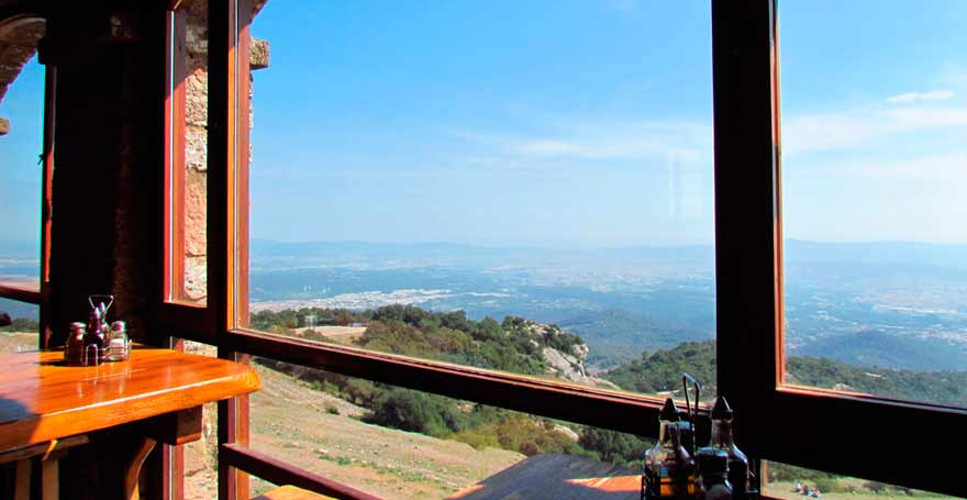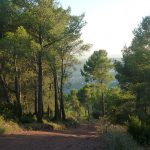
Route through the area between Sentmenat and Caldes de Montbui, in the Northeast area of the region. It is a circular road, of an hour and a half approximately, which shows the unique landscape of the plain of the Vallès, combination of dry farming and Mediterranean forest in the area.
Possible routes of longer duration, of a whole morning or afternoon, of the whole day and even weekend, always by natural and well preserved places, of medium mountain, near the Parc Natural de Sant Llorenç del Munt i l’Obac. They also offer journeys towards the plain of the Vallès, especially recommended in winter.
ROUTE
This route is a good sample of the rural landscape which, throughout history, has been part of the region, before the expansion of the residential areas and the industrial estates. Between the municipalities of Sentmenat and Caldes de Montbui, we will get through different masies and see subtle varieties of Mediterranean forest.
We get out of the horse-riding to the right and then cross a torrent with banana trees, poplars and American cane. We follow the street and in the curve we continue on the dirt road. On the right, we have a fenced forest farm. We see a forest of white pine and oak, with an undergrowth of rosemary, heather, steppe and mastic.
We take the narrow path with the indication towards Can Senosa, and at the junction, where there are signs of bikes, we take right making a slight descent. We continue with white pine forest up to the river where we find a lot of American cane and large brambles on the left. Just after passing the ravine we can see some wild rose bushes on the left margin, close to the path. Here we see how the forest is mixing with oak on the left and on the right, the field opens full of broom and fennel.
Here the way is plain, we see white pine and young oak. Behind we already see grain fields and when we arrive we can see the masia of Can Fruitós. On the left, we leave a mountain path toward the castle of Gallifa among other destinations. We arrive to the front of the masia, passing first by the side of the raft of water to the left and, practically at the door, we see a large set of laurel with fig trees that mark the detour to the left. We take it and see how we stand up to Can Fruitós mountain.
We go through the middle of the fields, the margins are raising full of bush and fennel and when the road begins to rise, we have pine forest with oak, again. On the right we can see a large oak that takes advantage of the humidity of the torrent.
We go up the path, pass the torrent and leave a detour to the right and continue straight up. In the margins we can see grey-leaved cistus of hairy and clear leaves, and fuchsia flowers and sage-leaved rock-roses, shorter, with dark leaves and white flowers, rosemary and genista scorpius.
On the right margin we can see the schist rock, as it breaks into thin slices, which is appearing between the clay soil more copper. In the middle of the climb we can see how among the trees they appear mastic, arbutus, redoul and some dispersed oaks. Shortly after on the right we will see a small path that climbs diagonally. We will heard for it until it forms a small square. Here we have a good viewpoint of the valley.
We go back on the path until the main road that we take to the right, above, up to the hill of Català where there is a detour: toward Sant Sebastià de Montmajor and Santa Maria del Grau to the right and to the left to Sentmenat. We take the latter down. The ground is still soft, clay. The road goes down slightly, under the shade of a dense forest of pine and young oak. In a curve to the left we cross a small torrent.
There is a path that moves straight on towards the plain of the Absoltes. Here we can see pine trees full of ivy and smilax, with brighter leaves and with thorns. When the road opens up slightly to the right, we see the crop fields of Can Senosa and the masia that is protected by the right margin. If we look, above a rock we can see the castle of Guanta, old fortified masia where there is a restaurant now.
We continue down and when the road becomes almost flat. In a curve to the right we will pass a small water stream. On the left we can see the figure of a virgin, surrounded by flowers that brings the people from Sentmenat. After passing the torrent we will find a bank made with reddish stone, of the area.
We continue the more limestone path, with a more clear forest of pine, until we see the detour that we caught at the beginning to go to Can Fruitós, and that now is on the left. We follow the forest track forward until the entry to the residential area, we pass the river by the bridge again and, to the left, we enter the horse riding.
ACCUMULATE GRADE

DON’T MISS…

Can Fruitós: masia that takes its name from an ancient chapel dedicated to Saint Fruitós. Until 1868 it belonged to the former territory known as Condal. It was a chapel located in the municipality of Sentmenat, but that depended on the parish of Caldes. His name appears for the first time in 1066.
The masia presents the typical structure of the masia from the 18th century; but different subsequent reforms have given it a different physiognomy, which corresponds more to a masia of the last century. Nevertheless, it maintains many of its original structures. In the inner side courtyard there are two Gothic arches very slender and very nice. At its side, the annexed Romanesque chapel is kept in very good conditions. It is a simple plant chapel, with a barrel vault. From the same path you can see the apse.
Can Senosa: also known as Cortijo de Aiguasenosa, located in the valley of the same name and in the territory of the antique Condal. Its name appears for the first time in 1002. Several reforms and modifications have blurred its original form; despite everything, you can still see a Gothic window of the primitive construction
Casa de Guanta (it is visible from afar): the House of Guanta is from before the 15th century, but the documentation of the existence of this masia is unclear, although there are reports of the Guanta and Castellet de Guanta lineages since the 13th century. The distinction between little castle and house cannot be done until the 15th century.
Castell de Guanta (seen from afar): above the House of Guanta, on the hill of the Corb or of the Moro, it lies the castle of Guanta or of the Muslims, of which there only remain small debris. It is also called castle of the Moro. By documentary chronology, it is previous to the castle of Sentmenat, since it is first mentioned in 1012. It seems that the origin of the place named Guanta is in the name of a person of the 10th century, Gonter. The Castle of Guanta was part of the network of defence castles and christian watchtowers against the raids of the Muslim troops located beyond the Llobregat. It was, according to legend, a refuge for count Borrell.
SUGGESTIONS
The forest and the torrent of the Guanta, the mountain of the Creu, the dolmen of Serra Cavallera, the mas d’en Cisa, the castle of Sentmenat, the tower Roja and the remains of an Iberian settlement in the surroundings are points of interest near this route.
Also you may be interested in…

Visit our producers
Taste the unique flavours of the Vallès directly by the hand of their producers.

Route of the Pont del Masover
Fall in love with the agricultural landscape that surrounds the villa of Ullastrell.

Unique restaurants
We have compiled a list of unique and high-quality restaurants in the Vallès. Will you miss them?





No Comments